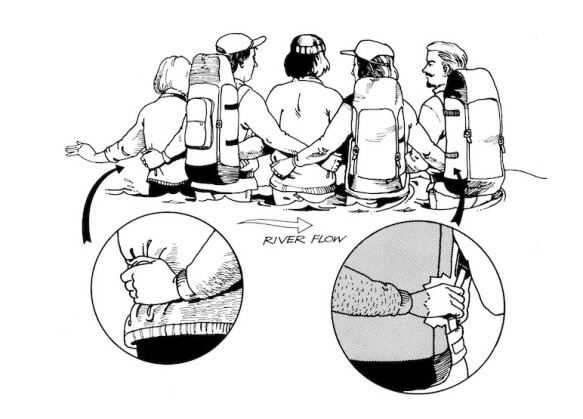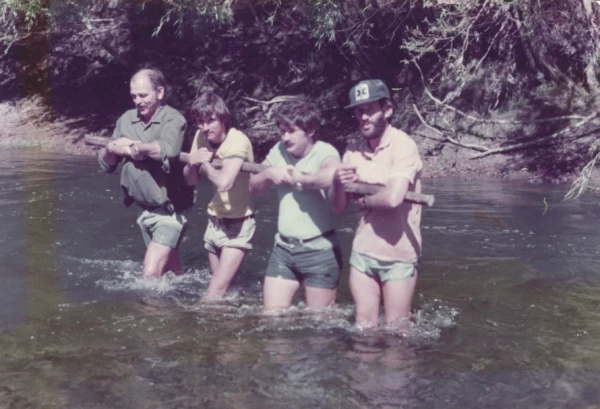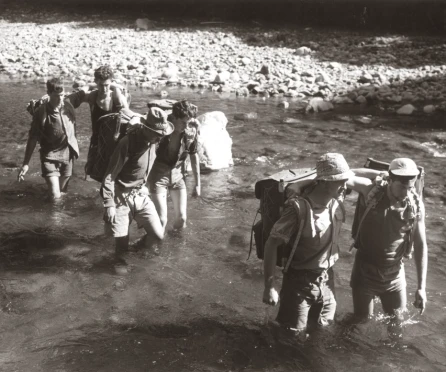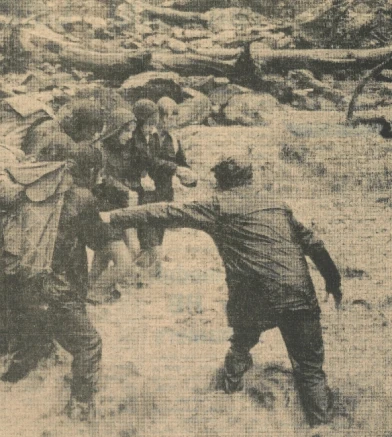River Safety: History of the Mutual Support Method
Rivers, specifically the act of crossing them, have claimed many lives in Aotearoa. Historically referred to as ‘the New Zealand death’ river crossing fatalities have long been associated with our great outdoors, and hunting and tramping. Nowadays, the mutual support method is universally accepted as the best practice standard for group river crossings. So where did it come from and why?
New Zealand Mountain Safety Council (MSC) instructors developed the mutual support technique in the early 1990s through robust field testing, led by Bushcraft Programme Manager Ray Goldring, as they sought a safer method for river crossings.
"I realised that the change in the design of tramping packs from external frames to internal frames needed a different way to cross rivers safely," says Ray.
The old method, using a horizontal pole or sturdy stick with everyone lined up and holding on, was not truly "mutual supporting" as a group member could easily get washed away if they lost their grip on the pole. If this happened, the advice of the day was to place their thumbs into the external frame of their pack to hold it down and use their legs to "cycle" their way to the nearest bank.
With the invention of internal frame packs, like the models we see today, this approach was not possible, so Ray begun to look into an alternative method, and a different technique if someone was separated from the group during the crossing.
"I collated all the known river-crossing methods from around the world, along with the method used in New Zealand at the time, and we got together 20 of our most experienced MSC instructors to meet in Turangi,” says Ray.
The group spent two tiring days on the Tongariro River testing all the known river-crossing methods to destruction, in river conditions Rays says most would not (or should not) attempt. By the end of the weekend and dozens of crossings later, they had devised a safer way to cross a river: the current mutual support method. The technique involves standing in tight formation side by side and placing your arms between the back and pack of the person next to you and grasping their hip belt.
They also learnt that if a person became separated, with their waist-belt done up, they could use their pack as a floatation device with their arms free to ferry-glide (paddle) themselves to the nearest bank.
“After that session I embarked on a series of nationwide sessions for all MSC instructors, where we trained them in the new method,” says Ray.
When the MSC Bushcraft Manual, long the gold standard for all bushcraft-related skills, was updated in 1995 by Ray and his team, they include the new mutual support method. Over the following years some tweaks were made to describe an escape or retreat method – the "folding-snake" or “caterpillar” method was introduced as the safest technique for returning to the launch-bank if the crossing needed to be aborted, rather than backing out as previously prescribed.
The mutual support river crossing method has without question prevented river crossing fatalities and continues to be the best practice for group crossings. MSC is incredibly proud of the role it played in the development of this ground-breaking technique.
 The mutual support method developed by MSC in the 1990s is the safest way for a group to cross a river.
The mutual support method developed by MSC in the 1990s is the safest way for a group to cross a river.Explore Our River Safety Resources
- River safety skills | Learn essential river crossing skills including the mutual support method
- Know how to cross | Watch our river crossing safety video
- Get the training | Find a river crossing course
Read Our River Crossing Stories
- Tramping party makes life-changing river crossing decision
- Turning around can be the hardest decision to make at a river
PHOTO CREDIT | NZ Mountain Safety Council | From the archives: River crossings during the 1970s and 1980s


